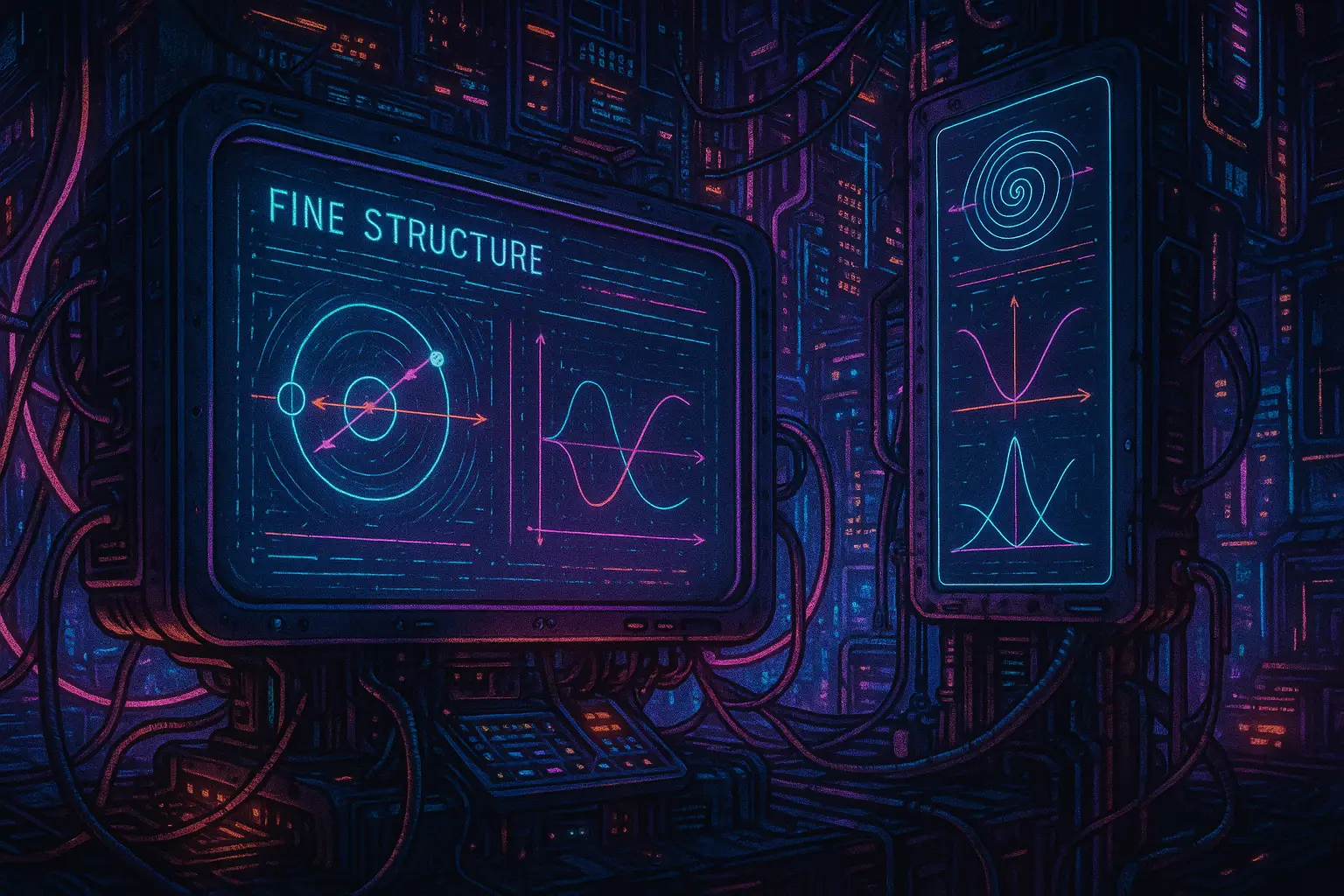Table of Contents
- Introduction
- What Is Fine Structure?
- Sources of Fine Structure
- Spin-Orbit Coupling: The Physical Picture
- Mathematical Formulation of Spin-Orbit Interaction
- Derivation from Magnetic Interaction
- Total Angular Momentum \( \vec{J} = \vec{L} + \vec{S} \)
- Quantum Numbers and Term Symbols
- Fine Structure Splitting in Hydrogen
- Energy Corrections: Dirac and Pauli Theories
- Selection Rules and Transition Lines
- Fine Structure in Multi-Electron Atoms
- Spectroscopic Observations
- Relativistic Origin and Historical Significance
- Applications and Experimental Techniques
- Conclusion
1. Introduction
In atomic physics, fine structure refers to small but significant corrections to atomic energy levels that arise due to relativistic effects and spin-orbit interaction. These corrections lead to the splitting of spectral lines that would otherwise be degenerate in the non-relativistic Schrödinger model. Understanding fine structure is essential to achieving high precision in spectroscopy and in understanding the full quantum mechanical behavior of atoms.
2. What Is Fine Structure?
Fine structure is observed as a splitting of spectral lines due to corrections that include:
- Relativistic corrections to the electron’s kinetic energy.
- Interaction between the electron’s magnetic moment (due to spin) and the magnetic field created by its orbital motion — known as spin-orbit coupling.
- The Darwin term, which arises from the relativistic zitterbewegung (trembling motion) of the electron.
3. Sources of Fine Structure
These corrections collectively modify the energy levels of atoms, especially noticeable in hydrogen and hydrogen-like systems. They are:
- \( \Delta E_{\text{rel}} \): The relativistic kinetic energy correction.
- \( \Delta E_{\text{SO}} \): The spin-orbit coupling correction.
- \( \Delta E_{\text{Darwin}} \): The Darwin term affecting s-orbitals.
4. Spin-Orbit Coupling: The Physical Picture
From the electron’s perspective (its rest frame), the nucleus appears to orbit the electron, generating a magnetic field. This magnetic field interacts with the magnetic dipole moment of the electron caused by its intrinsic spin, leading to a coupling energy that depends on the relative orientation of the spin and orbital angular momentum.
5. Mathematical Formulation of Spin-Orbit Interaction
The spin-orbit coupling term in the Hamiltonian is typically written as:
\[
\hat{H}_{\text{SO}} = \xi(r) \vec{L} \cdot \vec{S}
\]
Where:
- \( \vec{L} \) is the orbital angular momentum operator.
- \( \vec{S} \) is the spin angular momentum operator.
- \( \xi(r) \) is a function depending on the radial distance and the potential.
For hydrogen-like atoms:
\[
\xi(r) = \frac{1}{2 m_e^2 c^2 r} \frac{dV}{dr}
\]
6. Derivation from Magnetic Interaction
In the electron’s rest frame:
- The magnetic field from the moving nucleus is:
\[
\vec{B} = \frac{1}{4\pi\varepsilon_0} \cdot \frac{Ze}{m_e c^2 r^3} \vec{L}
\]
- The spin magnetic moment of the electron is:
\[
\vec{\mu}_s = -g_s \mu_B \frac{\vec{S}}{\hbar}
\]
- The spin-orbit energy shift becomes:
\[
\Delta E = -\vec{\mu}_s \cdot \vec{B}
\]
7. Total Angular Momentum \( \vec{J} = \vec{L} + \vec{S} \)
Total angular momentum is given by:
\[
\vec{J} = \vec{L} + \vec{S}
\]
The value of \( \vec{L} \cdot \vec{S} \) can be expressed in terms of quantum numbers as:
\[
\vec{L} \cdot \vec{S} = \frac{1}{2} \left( J^2 – L^2 – S^2 \right)
\]
8. Quantum Numbers and Term Symbols
Energy levels split into sub-levels labeled by term symbols:
\[
^{2S+1}L_J
\]
Where:
- \( S \) is the total spin quantum number.
- \( L \) is the total orbital angular momentum (S = 0, P = 1, D = 2, F = 3, etc.).
- \( J = L + S, L + S – 1, …, |L – S| \)
9. Fine Structure Splitting in Hydrogen
Using the Dirac equation, the corrected energy levels are:
\[
E_{n,j} = -\frac{m_e c^2 \alpha^2}{2n^2} \left[ 1 + \frac{\alpha^2}{n^2} \left( \frac{n}{j + 1/2} – \frac{3}{4} \right) \right]
\]
Where:
- \( \alpha \) is the fine-structure constant.
- \( n \) is the principal quantum number.
- \( j \) is the total angular momentum quantum number.
10. Energy Corrections: Dirac and Pauli Theories
The Dirac equation, which naturally includes relativistic and spin effects, gives the full fine structure without ad hoc corrections. In contrast, the Pauli equation introduces spin in a semi-classical way and adds correction terms to the Schrödinger Hamiltonian.
11. Selection Rules and Transition Lines
Allowed transitions must obey selection rules:
- \( \Delta J = 0, \pm 1 \) (except \( J = 0 \rightarrow J = 0 \) is forbidden)
- \( \Delta L = \pm 1 \)
- \( \Delta S = 0 \)
Fine structure explains the splitting of spectral lines into multiple closely spaced components.
12. Fine Structure in Multi-Electron Atoms
In multi-electron atoms:
- Electrons interact through LS coupling (Russell-Saunders coupling) in light atoms.
- jj-coupling is used for heavy atoms.
- Energy levels depend on both the total spin and total orbital angular momentum of the entire system.
13. Spectroscopic Observations
Fine structure is visible in:
- Hydrogen spectral series.
- Sodium D-lines (\( 589.0 \) nm and \( 589.6 \) nm).
- Helium transitions.
Observed with high-resolution instruments like Fabry–Pérot interferometers.
14. Relativistic Origin and Historical Significance
- Validated special relativity in atomic physics.
- Led to the development of the Dirac equation.
- Confirmed the existence and role of electron spin.
15. Applications and Experimental Techniques
- Fine structure is used in atomic clocks for time standards.
- Influences laser cooling and trapping.
- Essential in quantum electrodynamics and testing the standard model via precision spectroscopy.
16. Conclusion
Fine structure and spin-orbit coupling enrich our understanding of atomic structure by including relativistic and intrinsic spin effects. They provide the basis for interpreting high-resolution spectra and have critical applications in technology, fundamental physics, and quantum information science.


